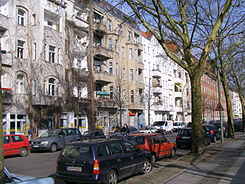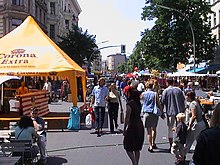Bergmannstrasse (Berlin)
| Bergmannstrasse | |
|---|---|
| Street in Berlin | |
| Bergmannstrasse (eastern part) | |
| Basic data | |
| place | Berlin |
| District | Kreuzberg |
| Created | in the first third of the 18th century |
| Hist. Names | Weinbergsweg |
| Connecting roads |
Kreuzbergstrasse (west) , Südstern (east) |
| Cross streets |
Am Tempelhofer Berg , Nostizstrasse , Solmsstrasse , Schenkendorfstrasse , Zossener Strasse , Friesenstrasse , Heimstrasse , Schleiermacherstrasse , Baerwaldstrasse |
| Places | Marheinekeplatz |
| Buildings | Market hall XI |
| use | |
| User groups | Road traffic |
| Technical specifications | |
| Street length | 1300 meters |
The Bergmannstraße in Berlin district Kreuzberg extends from Mehringdamm to Südstern / Gneisenaustraße in west-east direction. It was named on April 20, 1837 after the large landowner Marie Luise Bergmann (1774-1854, nee Neumann), who owned the lands in this area.
History and naming
Until the renaming of the street, which the Bergmann family had expanded in the 19th century, it was called Weinbergsweg . Since 1809, the entire area south of Bergmannstrasse, for example from Friesenstrasse to the former Bock brewery , had been owned by the Bergmann family. It has been designated as a public road since 1861. At first it was also written Bergemannstrasse .
A side street off Bergmannstrasse, Schenkendorfstrasse , was the place where Peter Lorenz , a top candidate of the Berlin CDU , kidnapped 3 days before the election for the Berlin House of Representatives in 1975 , was trapped in the basement under a second-hand shop in house number 7 for six days was held. This place was only a few meters away from his party's district office.
The "Bergmann" in the 21st century
After the political change, Bergmannstrasse has developed into a promenade with numerous cafés, restaurants, snack bars and small shops, which gives the surrounding densely populated quarter the name Bergmannkiez . Today's residents and businesses also refer to it as the “most colorful street in Berlin” and rate it as an “intact neighborhood with good infrastructure and a high quality of life”.
Halfway along, at the end of Zossener Straße , the Marheinekehalle is one of the last historical market halls in Berlin on Marheinekeplatz . The square was named after the Protestant theologian Philipp Konrad Marheineke . The Passion Church is located on the square .
During the Second World War , the Wilhelminian style houses around Bergmannstrasse suffered only minor damage, but the Marheinekehalle burned down.
Uses
Since 1994 the street festival Kreuzberg jazzt! Has been held in the western half of Bergmannstraße every year in June . instead of. This is with over 300,000 visitors, three music stages with over 50 bands, a theater stage with Kiez fashion show and the simultaneous event Kreuzberg kocht! at Chamissoplatz , where Kreuzberg's top chefs offer culinary samples, one of the most important festivals in the district and one of the biggest jazz events in Berlin.
Since September 20, 2008, the eastern part of Bergmannstrasse between Südstern and Marheinekeplatz has been designated as a bicycle route . Police checks to ensure compliance with the traffic regulations applicable there were carried out eleven times in 2016, twice in 2017 and twice in the first half of 2019. During the controls in the first half of 2019, a total of four violations due to unauthorized parking with disabilities were found.
According to the foot traffic strategy adopted by the Berlin Senate in 2011, a meeting zone is to be tested on the western part of Bergmannstrasse between Zossener Strasse and Mehringdamm . The encounter zone consists of street markings and furniture that have cost more than 860,000 euros so far.
Architectural monuments along the road
Numerous first buildings from the end of the 19th century have been preserved and have been extensively renovated. The following residential buildings and school buildings are under monument protection :
- Bergmannstrasse 1–4: tenement houses from 1871, 1877 and 1893
- Bergmannstrasse 5–7: substation built by Hans Heinrich Müller , 1929–1931
- Bergmannstrasse 8–10: Buildings belonging to the Chamissoplatz monument ensemble
- Bergmannstrasse 12/13 and 15–20: tenement houses from 1874 to 1879
- Bergmannstraße 28/29: former 133rd and 149th community dual school based on designs by city building officer Hermann Blankenstein opened in 1885
- Bergmannstrasse 60–65: former 60th and 236th community school based on plans by Ludwig Hoffmann and Fritz Haack , 1901/02
- Bergmannstrasse 39–41, 42–44 and 45–47: cemeteries on Bergmannstrasse
Web links
- Bergmannstrasse. In: Street name lexicon of the Luisenstädtischer Bildungsverein (near Kaupert )
- Weinbergsweg . In: Luise.
- Bergmannstrasse on berlin.de
- Bergmannstraßenfest on the website of the Kiez und Kultur association
Individual evidence
- ↑ a b Bergmannstrasse. Colorful mix . In: Peter Brock (Ed.): Berlin streets rediscovered. 33 forays through the capital. Jaron Verlag, Berlin 2003, ISBN 3-89773-114-2 , pp. 27-32.
- ^ Bergmannstrasse: The big eating. In: Der Tagesspiegel , July 30, 2010
- ↑ Written question from Member of Parliament Dr. Stefan Taschner (GREEN)
- ↑ Freedom of information requests - FragDenStaat. Retrieved July 28, 2020 .
- ↑ Bergmannstrasse encounter zone costs over one million euros. In: Berliner Morgenpost , May 20, 2019
- ↑ Bergmannstrasse 1 , Bergmannstrasse 2 ,Bergmannstrasse 3 ,Bergmannstrasse 4
- ↑ Bergmannstrasse substation
- ↑ Bergmannstrasse 8-10
- ↑ Bergmannstrasse 12 ,Bergmannstrasse 13 ,Bergmannstrasse 15 ,Bergmannstrasse 16 ,Bergmannstrasse 17 ,Bergmannstrasse 18 ,Bergmannstrasse 19 ,Bergmannstrasse 20
- ↑ Double school Bergmannstraße 28/29
- ↑ Bergmannstrasse 60–65 school
Coordinates: 52 ° 29 ′ 21 ″ N , 13 ° 23 ′ 38 ″ E


